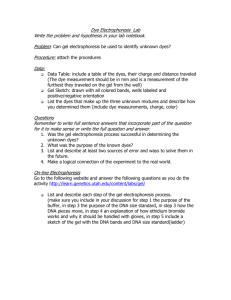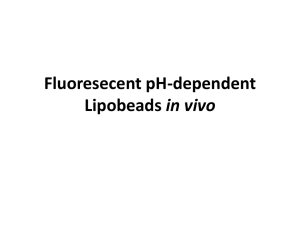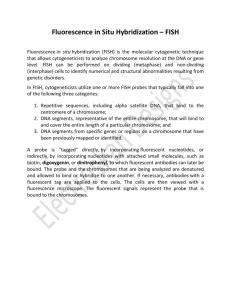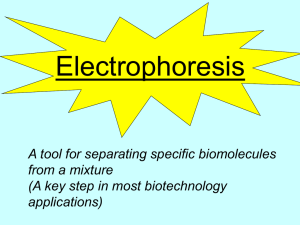chapter 13 summary exam 2
advertisement
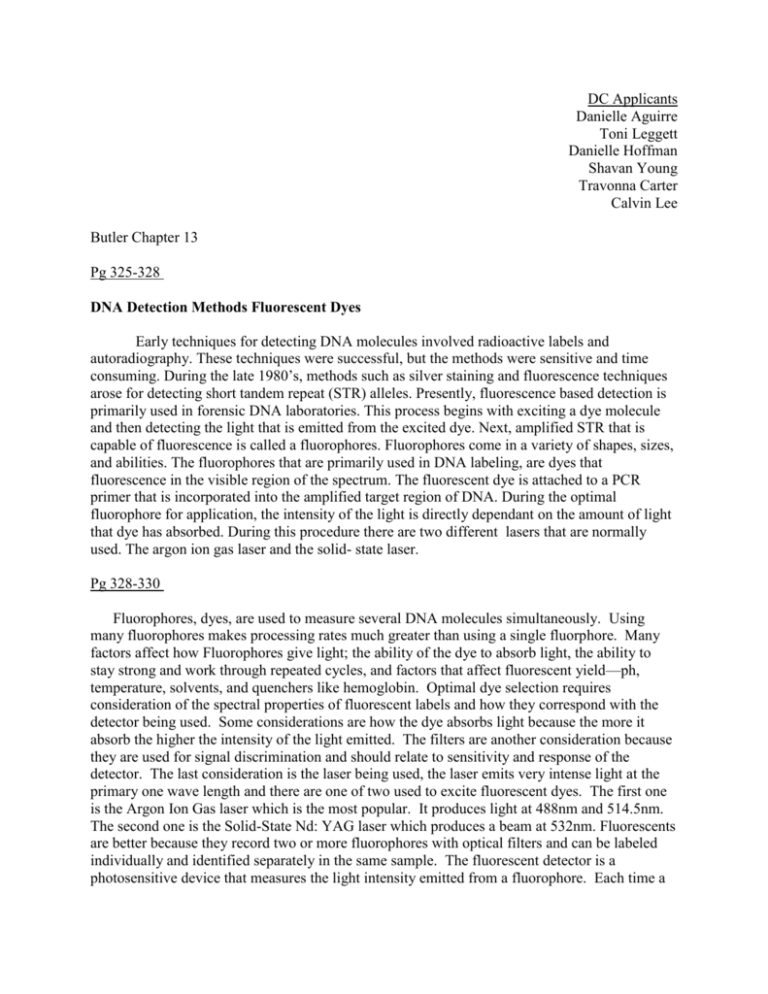
DC Applicants Danielle Aguirre Toni Leggett Danielle Hoffman Shavan Young Travonna Carter Calvin Lee Butler Chapter 13 Pg 325-328 DNA Detection Methods Fluorescent Dyes Early techniques for detecting DNA molecules involved radioactive labels and autoradiography. These techniques were successful, but the methods were sensitive and time consuming. During the late 1980’s, methods such as silver staining and fluorescence techniques arose for detecting short tandem repeat (STR) alleles. Presently, fluorescence based detection is primarily used in forensic DNA laboratories. This process begins with exciting a dye molecule and then detecting the light that is emitted from the excited dye. Next, amplified STR that is capable of fluorescence is called a fluorophores. Fluorophores come in a variety of shapes, sizes, and abilities. The fluorophores that are primarily used in DNA labeling, are dyes that fluorescence in the visible region of the spectrum. The fluorescent dye is attached to a PCR primer that is incorporated into the amplified target region of DNA. During the optimal fluorophore for application, the intensity of the light is directly dependant on the amount of light that dye has absorbed. During this procedure there are two different lasers that are normally used. The argon ion gas laser and the solid- state laser. Pg 328-330 Fluorophores, dyes, are used to measure several DNA molecules simultaneously. Using many fluorophores makes processing rates much greater than using a single fluorphore. Many factors affect how Fluorophores give light; the ability of the dye to absorb light, the ability to stay strong and work through repeated cycles, and factors that affect fluorescent yield—ph, temperature, solvents, and quenchers like hemoglobin. Optimal dye selection requires consideration of the spectral properties of fluorescent labels and how they correspond with the detector being used. Some considerations are how the dye absorbs light because the more it absorb the higher the intensity of the light emitted. The filters are another consideration because they are used for signal discrimination and should relate to sensitivity and response of the detector. The last consideration is the laser being used, the laser emits very intense light at the primary one wave length and there are one of two used to excite fluorescent dyes. The first one is the Argon Ion Gas laser which is the most popular. It produces light at 488nm and 514.5nm. The second one is the Solid-State Nd: YAG laser which produces a beam at 532nm. Fluorescents are better because they record two or more fluorophores with optical filters and can be labeled individually and identified separately in the same sample. The fluorescent detector is a photosensitive device that measures the light intensity emitted from a fluorophore. Each time a photon strikes the detector it creates an electric signal and the strength of the electric in typically reported in fluorescent units. Methods for fluorescent labeling of PCR products are done in three ways: putting a fluorescent dye into the amplicon through a 5’-end labeled oligonucleotide primer, putting fluorescent dNTP’s in the PCR product, or using a fluorescent intercalating dye to bind to DNA. All of these methods have their advantages and disadvantages. They can change the overall size of the DNA conjugate but that can be fixed with software. Genotyping of alleles is always performed relative to allelic ladders that are labels with the SAME fluorescent dye so that the differences in mobilities do not impact allele calls Pg 330-334 Fluorescence Detection Fist starts when the Laser Strikes a flourophore which is dye that is attached to the end of the DNA fragment. As the fluorophore takes the energy form the laser and transmits light at a lower level. Then the filters are used to collect the transmitted light at a wavelength. There are Photomultiplier tubes or charge-couple devices that are used to collect and amplify the signal form the fluorophore and change it into a electronic signal, Then the signals are measured into fluorescene units and make up peaks that are electropherograms or bands on a gel image. Advantages The advantage of Fluorescence detection are that there is a higher sensitivity and broader dynamic range than comparable colorimetric detection and the samples are more complex with the multiplex PCR products with different fluorescent Labels. Fluorescent Dyes Used for STR Allele Labeling Dyes are used to distinguish the PCR products for geno typing applications There are chemical names for the dyes: ex 5-FAM 5 carboxy flourescein , SYBR Green Propritary to Molecular Probes When Labeling the DNA it is important to use the right concentrations of the dyes in order to keep the balance between the loci. Pg 335-338 Issues with Fluorescence Measurements Color Deconvolution: Multi-component analysis is performed with a mathematical matrix that subtracts out the contribution of other dyes in each measured fluorescent dye. When raw data is collected overlap of the dyes must be accounted for enable to see the individual results for each dye. One way to do this is to examine the Matrix Standard Samples. Then a computer software program is used to analyze the data from the individual dyes and a matrix file is created to reflect the color overlap. Matrix File table (see figure) four rows and four columns. The matrix file has a diagonal row of 1.000 values the values that are less than 1.000 are what represent the overlapping dyes. The highest .8300 is what represents the largest amount of overlap. For example in row B, the most significant overlap occurs between the blue and the green. Matrix files are different between instruments and run conditions. The fluorescent dye is affected by its environmental conditions, such as temperature and pH levels. Frequent testing and constant in electrophoresis conditions will allow for the results to be reproducible and spectral overlap will be accurately deciphered. If matrix color deconvolution doesn’t work properly than the baseline can be uneven or ‘pull ups’ can occur. Pull-ups are the result of color bleeding that will be in one spectral to another most of the time because of off-scale peaks. Often time pull up can be recognized by small green peaks occurring under off scale blue peaks. This can occur because of significant overlap between blue and green dyes. You can prevent or reduce these peaks by diluting the sample and analyzing it again. Pg 338-342 Florescence Detection Platforms A number of Florescence Detection Platforms exist and have been used for STR allele determination. In the United States the most popular platform used are ABI Prism 310 Genetic Analyzer, the ABI 3100 multi-capillary system, and the FMBIO II gel scanner. ABI Prism 310 is performed during electrophoresis. A company by the name of Applied Biosystems prepared Profiler Plus and COfilers STR kits to work on ABI detention Platforms. These Kits were called PowerPlex 16 and Identifier STR. Both of these kits enable amplification of all 13 CODIS. FMBIO II is a gel scanning system that is performed following electrophoresis. Many gels can be run in separate gel rings and detected via rapid scanning on a single FMBIO fluorescence imaging system. The Promega Corporation created several Multiplex STR Kits to work with the FMBIO II detection platform: PowerPlex 1.1, PowerPlex 2.1, and PowerPlex 16 Bio. These kits enable amplification of the 13 core CODIS STR loci with either the combination of PowerPlex 1.1 ad n2.1 and 2.1 or PowerPlex 16 BIO, which amplifies all 113 CODIS loci plus Penta D and E in a single multiplex reaction. Silver Staining Silver staining is useful for detecting small amounts of proteins and visualizing nucleic acids. Silver Staining procedures were used for the first commercially available STR kits from the Promega Corporation. Silver-stain detection are still quite effective for laboratories that want to perform DNA typing for a much smaller start-up cost. The procedures for silver staining is performed by transferring the gel between pans filled with various solutions that expose the DNA bands to a series of chemicals for staining purposes. First the gel is submerged in a pan of 0.2% silver nitrate solution. At this point the silver binds to the DNA and is reduced with formaldehyde to form a deposit of metallic silver on the DNA molecules in the gel. A Photograph is then taken of the gel to capture images of the silverStained DNA strands. Advantages and Disadvantages of Silver Staining The primary advantage of silver staining is that the technique is inexpensive. The developing chemicals are readily available at low cost. The PCR products do not need special labels. The staining can be completed within a half hour and with minimal number of steps. A disadvantage is that both DNA strands may be detected in a denaturing environment leading to two bands for each allele.

